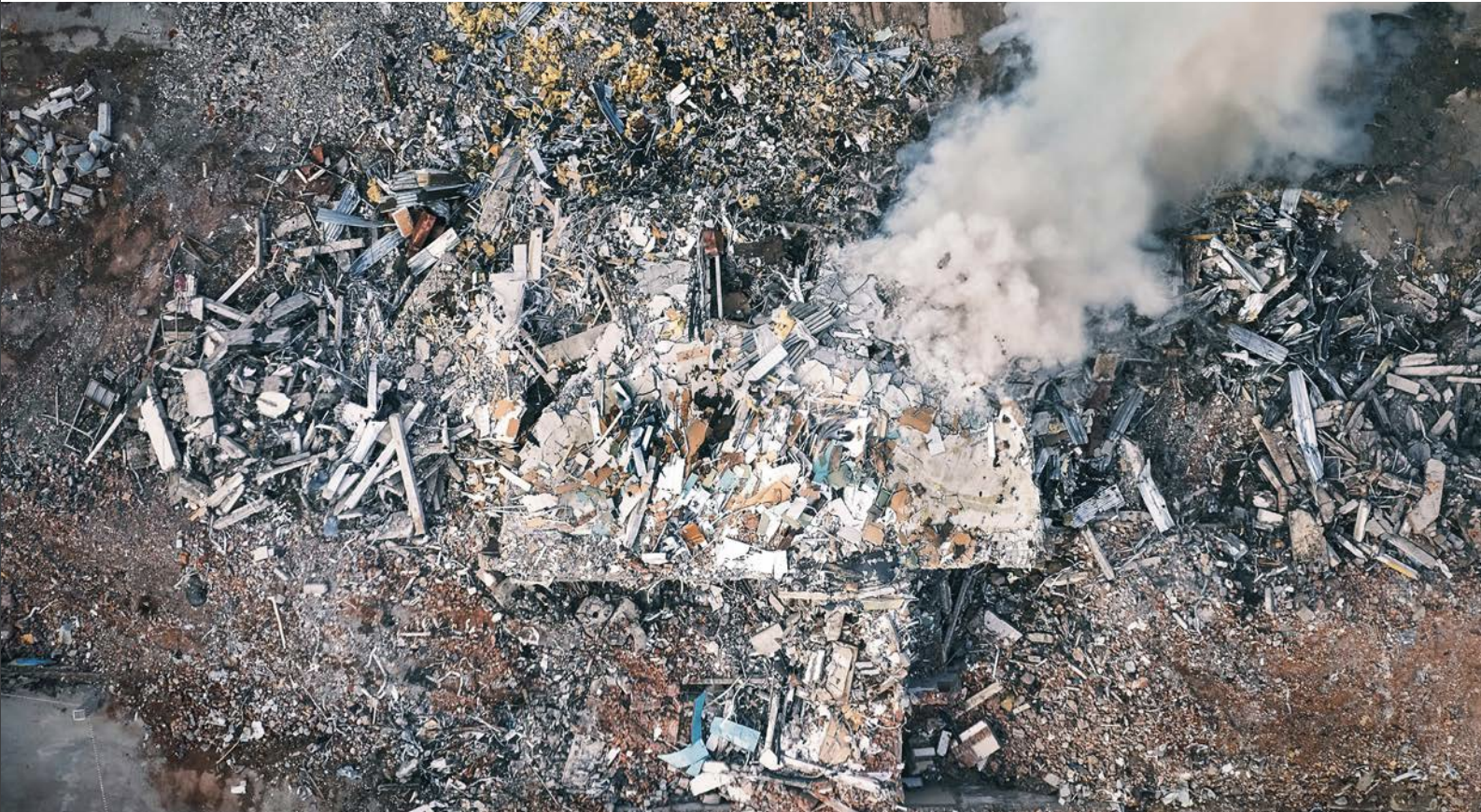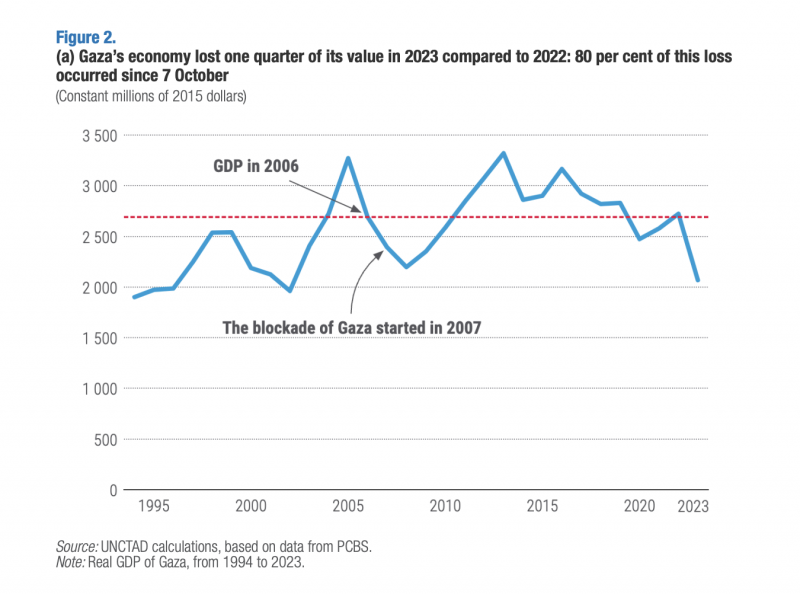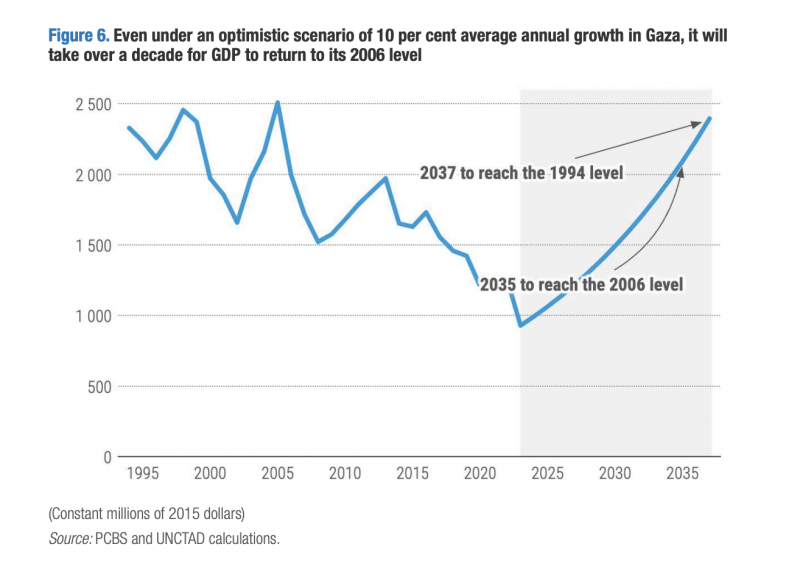
The United Nations Conference on Trade and Development (UNCTAD) released a report on January 31, 2024 in Geneva, Switzerland on the social and economic deterioration in Gaza since the beginning of the military operation after October 7, 2023. The report titled ‘Preliminary assessment of the economic impact of the destruction in Gaza and prospects for economic recovery’ quantifies GDP loss, recovery timelines, and enduring effects on poverty and household expenditure. It paints a daunting picture of the development challenges ahead.
Utilizing innovative satellite imagery and official data, UNCTAD currently estimates that Gazan economy had already contracted by 4.5% in the first three quarters of 2023. However, the military operation has greatly accelerated the decline and precipitated a 24% GDP contraction and a 26.1% drop in GDP per capita for the entire year. If the current military operation were to end immediately with reconstruction starting right away and the 2007-2022 growth trend persists with an average growth rate of 0.4 per cent, it would take Gaza until 2092 just to restore the GDP levels of 2022 with GDP per capita and socioeconomic conditions continuously declining. However, even with the most optimistic scenario that GDP could grow at 10% annually it would still take Gaza’s GDP per capita until 2035 to pre blockade level of 2006.


The recovery of Gaza's economy from the current military operation will demand a financial commitment, several times the $3.9 billion that resulted from the 2014 military operation in Gaza and will involve a concerted international effort to restore pre-conflict socioeconomic conditions.
Jean-Louis Arcand, President of the Global Development Network, and Daniele Rinaldo, Assistant Professor, Department of Economics, University of Exeter, United Kingdom of Great Britain and Northern Ireland contributed to the report.
Download and read the full report.
BACKGROUND
Since the early 1990s, and greatly amplified after 2007, the Palestinian people in Gaza have been subjected to prolonged and severe restrictions on their movement that, in combination with tight restrictions on trade in goods, in effect amount to a blockade on the densely populated 365 km² Gaza Strip. Furthermore, Israel does not allow the construction and operation of air or seaports and bans or restricts the importation of critical production inputs and technology.
Several Israeli military operations have taken place in Gaza, in 2008, 2012, 2014, 2021, 2022, May 2023 and October 2023. The operations caused internal displacement and recurrent destruction of physical infrastructure, residential buildings, capital stock and productive assets, including agricultural land, crops, livestock sheds, greenhouses, fruit trees, storage facilities, boats, fishing equipment, agribusinesses, irrigation canals, water pumping systems, electricity networks, Internet networks, factories, office buildings, housing units, educational facilities and health-care centres.
Prior to the outbreak of the latest Israeli military operation in October 2023, much of the damage from previous military operations remained unrepaired, while the inhabitants of Gaza were confined in one of the most densely populated spaces in the world, in chronic conflict conditions, with inadequate access to clean water, without electricity for half the day and without a proper sewage system. Close to half the workforce was unemployed and two thirds of the population lived in poverty.
Socioeconomic conditions in Gaza were dire in 2022 and the first half of 2023, with over two million Gazans confined to one of the most densely populated spaces in the world suffering inadequate access to clean water, sporadic electricity provision and without a proper sewage system. Two-third of the population lived in poverty and 45% of the workforce were unemployed before the beginning of the latest military operation.
UNCTAD’s assessment underscores that restoring pre-conflict socioeconomic conditions in Gaza will take decades and requires substantial foreign aid. As of mid-2023, two million Gazans faced challenges ranging from inadequate access to water and electricity to high unemployment. The ongoing military operation has displaced 85% of Gaza's population, halting economic activities and further worsening poverty and unemployment.
As of December 2023, unemployment had surged to 79.3%. Meanwhile, 37,379 buildings—equivalent to 18% of the Gaza strip's total structures—have been damaged or destroyed by the military operation. The Gaza Strip, half of who`s population are children, is now rendered almost uninhabitable with people lacking adequate sources of income, access to water, sanitation, health or education.
During the period 2006–2022, the GDP per capita of Gaza shrank by 27 per cent, from $1,994 in 2006 to $1,257 in 2022. According to the International Monetary Fund the military operation of 2014 debilitated 85 per cent of the capital stock that had survived the previous military operations.





